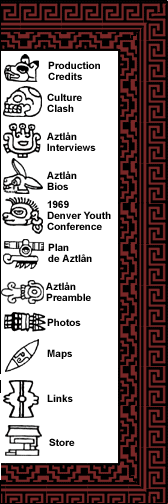

![]()
When Alurista first came out with the Preamble to the Plan de Aztlán at the 1969 Denver Youth Conference, he tapped into this basic feeling. Aztlán was suddenly important because this was the name of the homeland of our indigenous ancestors. Aztlán became a rallying cry. Suddenly we found a way to say: "Aquí estamos, here we are. Esta tierra es nuestra, this land is ours. We call it Aztlán. And even though it resides in myth, this myth is important. It is the story of our ancestors, we belong here." The concept of Aztlán gave us back the homeland that had been taken away from us. It also gave us identity. Once you have a sense that you belong, that a place is yours, it empowers you, gives you a sense of identity. You’re no longer a stranger in your own land. And if I belong here, then I can also partake in the fruits of the land. I don’t have to be a second class citizen. It gave us a great sense of power that we could take to the streets, to social protest, to organize. It also gave us a great deal of spiritual power. Which, to me, is even more important.
Aztlán is a myth. And we should understand it in the context of world mythology. Every community of people, that has ever existed creates myths. And by myth I mean story, legend. Myth becomes very powerful because the myth tells the people who they are. Where they came from. It gives them their value system, it empowers them to do things. I, myself, understood this power of the myth of Aztlán, because as a New Mexican, as a Nuevomejicano, I have always been very rooted in la tierra, the land. A great deal of my creative imagination, my energy, my subject matter, comes out of this land that my ancestors have lived in for such a long time. To me, the idea of la tierra is very powerful, because it is from that landscape, it is that tierra, that feeds the spiritual sense of who I am and where I belong and my potential and what I can do. Myth is always communal. Myth does not belong to one person. And that’s the beauty of this myth of Aztlán, this story of Aztlán. It belongs to all of us. Whether we’re Native American or Mexicanos, or Espanoles, we share in that myth. The beauty of a myth, or a legend, a story is that it is always communal. Stories belong to the people. The myth of Aztlán belongs to the people.
And so, we have a leap from the ‘60's, when we first started talking about Aztlán, to today. It was very important in the ‘60's and ‘70's, and I see that it continues to be important to young people today. And the young people are still carrying on that belief. Why? Because it filters throughout the community. And they want to know what it is, they want to know what Aztlán means to them. Aztlán is still very much alive. The idea of Aztlán and how it can empower you, make you creative, make you fulfill your potential--is very much alive. And it’s a story that doesn’t necessarily have to be understood rationally. It’s understood in the heart.
*******
Rudolfo Anaya is one of the most influential authors in Chicano literature, often referred to as “the Godfather of Chicano Literature.” His novels include Bless Me Ultima, Heart of Aztlán, Tortuga, The Legend of La Llorona, Albuquerque, Zia Summer and Rio Grande Fall. The above excerpt was condensed from the interview conducted for the In Search Of Aztlán video.
<<BACK
 |
 |
 |